Did Baby Bash Go to Classic Fun Center
The answer is all of the to a higher place—and more. Hip Hop embraces these artistic elements, most definitely. But it besides has blended and transcended them to go a means for seeing, jubilant, experiencing, understanding, against, and commenting on life and the globe. Hip Hop, in other words, is a way of living—acivilization.
The elements of Hip Hop came together in the Bronx civic of New York City. It was the early 1970s and times were tougher than usual for the poorer parts of urban America. From a whole lot of naught—and a whole lot of imagination—Hip Hop took form.
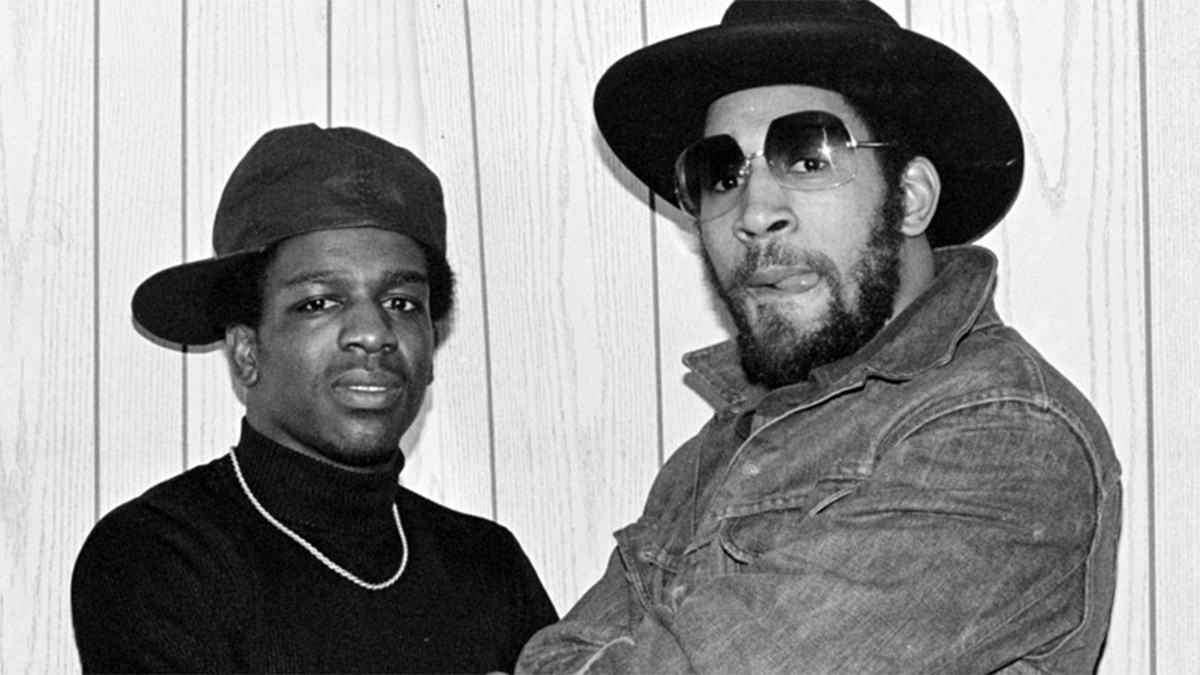
DJ Tony Tone and DJ Kool Herc, 1979 © Joe Conzo
DJ Kool Herc is credited with throwing the switch at an Baronial 1973 dance bash. He spun the aforementioned tape on twin turntables, toggling betwixt them to isolate and extend percussion breaks—the almost danceable sections of a song. Information technology was a technique that filled the floor with dancers who had spent days and weeks polishing their moves.
The result that night was electrical, and soon other DJs in the Bronx were trying to outdo Herc. It was a code that has flowed through Hip Hop e'er since: 1) Employ skills and whatever resources are bachelor to create something new and cool; 2) Emulate and imitate the genius of others just inject personal fashion until the freshness glows. Competition was, and remains, a prime motivator in the Hip Hop realm.
Like a powerful star, this dance-political party scene quickly drew other art forms into its orbit. A growing movement of hopeful poets, visual artists, and urban philosophers added their visions and voices by whatever means available. They got the discussion out about what was happening in their neighborhoods—neighborhoods much of mainstream, middle-class America was doing its best to ignore or run downward. Hip Hop kept coming, kept pushing, kept playing until that was no longer possible.
Today, some Hip Hop scholars fold every bit many as six elements into Hip Hop civilisation. They include:
- DJing—the artistic handling of beats and music
- MCing, akarapping—putting spoken-word poetry to a beat
- Breaking—Hip Hop'southward trip the light fantastic form
- Writing—the painting of highly stylized graffiti
- Theater and literature—combining Hip Hop elements and themes in drama, poetry, and stories
- Knowledge of self—the moral, social, and spiritual principles that inform and inspire Hip Hop ways of existence.
From its work-with-what-you-got epicenter in the Bronx, Hip Hop has rolled outward to become a multibillion-dollar business. Its sounds, styles, and fashions are now in play around the world. DJs spin turntables in Sao Paulo, Brazil. MCs rap Standard arabic in the clubs of Qatar. B-boys and b-girls bust baby freezes in Finland. Graffiti rises on the Great Wall of China. Immature poets slam poesy in D.C.
And then what is Hip Hop? All of the to a higher place and more—whatever we honey plenty to bring.
The Evolution Of Hip Hop [1979-2017]
Breaking: The Dance Style of Hip Hop
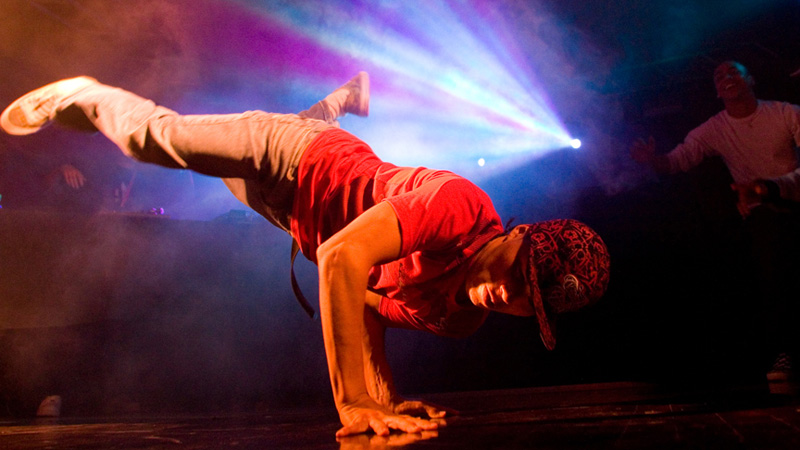 Prototype via Artistic Commons; flickr.com user Néstor Baltodano
Prototype via Artistic Commons; flickr.com user Néstor Baltodano
Richard Colón was just x when his cousin took him to his first schoolyard bash in 1976. "Ah, I was just blown abroad," he says in Jeff Chang'southward history of Hip Hop,Can't Stop Won't Stop. "I just saw all these kids having fun...checking out the whole scene, and it was my get-go time watching the dance with the music being played...I simply immediately became a part of it."
He soon became alarge function of it. By his early teens, the male child now immortalized as "Crazy Legs" became a trendsetter for breaking—a trip the light fantastic toe revolution still popping, locking, and rocking the world.
Making a B-line from the Bronx
As Hip Hop culture rose from the streets of the Bronx, breaking spun up and stepped out from the concrete itself. Early b(reaker)-girls and b-boys like Crazy Legs and his Rock Steady Coiffure earned their skills on that hard basis, admiring each other's cuts, bruises, and "boxing scars" as they pushed ane some other to evermore audacious displays of mode and guts.
In keeping with Hip Hop'southward ethic of improvisation, breaking is often a create-on-the-fly dance way. Information technology mixes super-quick footwork with torso-torquing twists. Robotic movements flow into shine whole-body waves before dropping into acrobatic leg flares that suddenly halt in mid-spin freezes that seem to defy gravity. Breaking is the ultimate iii-D trip the light fantastic—flipping high, spinning depression, and putting a premium on physical imagination and bravado.
Getting on the Skillful Pes
Breaking has copied from many dance styles to generate this uniqueness. These styles include the Charleston from 100 years ago that loaned its characteristic leg boot and arm swing as a top-rocking motion. The advertizement-libbing of the Lindy Hop, popular from the 1920s on, also lives in breaking's way. For individual inspiration, though, no ane can all-time soul singer James Brown. His loftier-energy trip the light fantastic moves in the 1960s and 70s have inspired b-boys and b-girls ever since, and his song "Get on the Proficient Foot" is one of breaking's early on anthems. Tap, steppin', ballet, disco, and modern all keep to contribute.
Breaking has rummaged beyond the dance floor and stage to notice many of its most dramatic moves. The whirling torsos and legs of gymnasts on the pommel horse are seen in leg flares, for example. Down-rocking reflects techniques from gymnastic flooring routines.The globe of hand-to-hand combat has also provided inspiration for b-boys and b-girls. Hip Hop scholars often link breaking withcapoeira, a martial arts dance with roots in Angola and Brazil that displays acrobatics, grace, and ability. A full-diddled showdown makes information technology clear why breaking contests are referred to equally "battles" every bit dancers mix dance moves with shadow kicks, leg sweeps, and false attacks in the faces of the competition.
Breaking is much more than a sum of moves from various dances and disciplines, though. It is a living, animate art form unique every fourth dimension dancers take their plough in a cypher (encounter sidebar). Through the years the Stone Steady Crew, the Mighty Zulu Kings, the Lockers, the Electrical Boogaloos, and thousands of other individuals and crews take continuously renewed and refreshed the style with original spins, fresh freezes, and new twists on power moves—frequently laced with body-bending humor. Competition and innovation in breaking—as with all things Hip Hop—is essential and inspired, and today its style inspires wherever people dance.
Flying Legs Crew: Kings of New York
Hip Hop Vocabulary
B-Terms to Know
The basic vocabulary of breaking—Hip Hop's dance way include:
popping fluid movements of the limbs, such every bit moving arms like an ocean moving ridge, that emphasize contractions of isolated muscles
locking snapping arms or legs into held positions, ofttimes at sharp angles, to emphasis a musical rhythm
top-rocking fancy footwork performed upright
down-rocking dance moves performed on or close to the ground
up-rocking martial arts strikes, kicks and sweeps built into the dance steps often with the intent of "burning" an opponent
ability moves acrobatic spins and flares requiring speed, strength, and agility
freeze sudden halt of a dance pace to hold a pose, often while balanced on a hand, shoulder, or caput
nil grouping of b-boys/b-girls taking turns in the center of the dance floor
DJing: The Artist at the Turntable
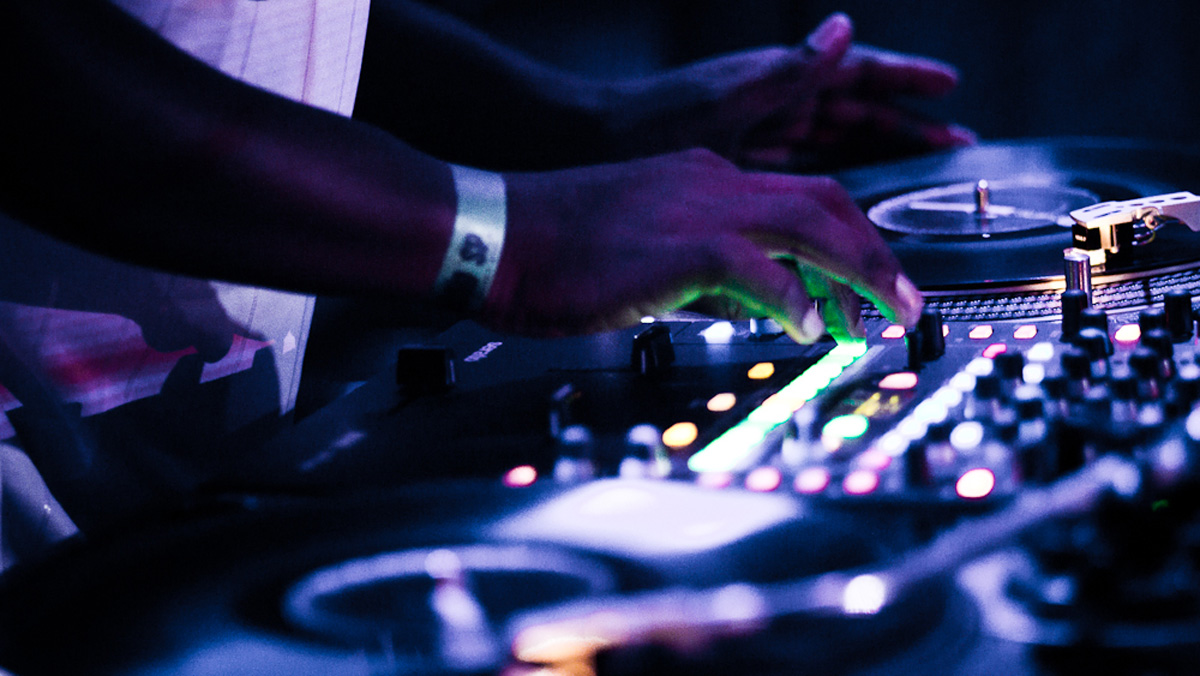 Image via Creative Commons; flickr.com user Fora practice Eixo
Image via Creative Commons; flickr.com user Fora practice Eixo
DJs are the soul behind the beat that pleases, surprises, and puts people on the trip the light fantastic floor. The all-time DJs accept an almost mystical sense of mood at a party or club. They sense the correct moment to cue the right vocal using the right technique to take the political party where it'south prepare to go. Information technology is that insight, a passionate noesis of music, and technical know-how that make DJing one of the pillars of Hip Hop civilisation.
Working the Audio Organization
A DJ'due south sound system is a laboratory for making music magic. Twin turntables are standard, allowing the DJ to switch easily between songs, or spin and manipulate records in tandem to create furnishings or unique musical combinations. The turntables are wired to a receiver, amplifier, and earthquake-causing speakers. The DJ may use headphones to cue upwardly the next song or song segment as the current music plays. Then he or she uses a mixer, or fader, to brand transitions from one turntable to the other—hopefully without missing a trounce. Today's DJs often incorporate digitized and computerized components, as well. But well-nigh Hip Hop purists frown on DJs who button-push preprogrammed playlists. Hip Hop culture saves its greatest praise for inspired improvisation.
Earlier the ascension of Hip Hop, the DJ's basic role was relatively elementary—spin records at a party, club, or on the radio. DJ Kool Herc'due south keen observations changed that game. He noticed the free energy on the trip the light fantastic floor went off the charts during the "breaks" of songs. Breaks are the instrumental sections in many pop and rhythm & dejection numbers that highlight percussion and rhythm.
Herc experimented with methods to extend these sections by playing the aforementioned record on both turntables, a technique refined past boyfriend pioneering DJ Grandmaster Flash. With needle-fine timing, they switched back and along between the turntables to multiply the break. Crowds, especially dancing b-boys and b-girls, couldn't get enough. Since the beginning, Hip Hop DJs have been instrumental in channeling youthful energy away from trouble and toward creative fun.
Good DJs constantly explore ways to pleasantly stupor their audiences. They may requite people the songs they look, planning out smoothen transitions by matching beats and musical keys from one number to the next. They besides innovate by listening for songs within songs, lifting and linking snippets to take the music somewhere new.
In the never-ending quest to distinguish their mix, DJs oft haunt used-tape stores. They are on the prowl for long-lost songs or sounds they tin can make new again through the magic of Hip Hop. Legendary DJ and all-around Hip Hop luminary Afrika Bambaataa is famous for creating sets that spin from the Pink Panther theme to Kraftwerk to calypso to speeches of Malcolm X and Martin Luther King, Jr. All that is skilful from the past and nowadays has a place at the Hip Hop turntable.
Scratching and Turntablism
As part of the Hip Hop manner of life, DJs are constantly experimenting to set up themselves autonomously from contest. One technique DJs embraced is scratching. To scratch, the DJ physically manipulates the record beneath the needle. Thou Wizzard Theodore stumbled on the technique in the mid-70s. He was a young teen blasting his music when his mom scolded him to turn it downwardly. He fumbled the needle, liked the consequence, practiced it, and began using it in shows. Other DJs quickly added scratching to their repertoire as a mode to inject more personal style into the music menstruation.
More recently, turntablism has get an phenomenal source of new fashion. Information technology involves all-encompassing real-fourth dimension sampling from spinning records to create something funky and fresh. Watching an experienced turntablist create in real time is an awe-inspiring experience.
Kool Herc "Merry-Go-Round" technique
Hip Hop Vocabulary
DJ-Terms to Know
The basic vocabulary ofDJing—Hip Hop's music manner include:
back spinning turntable technique that quickly "rewinds" a section of a recording
vanquish juggling manipulating two or more recordings to create a unique musical arrangement
trounce matching following a vocal with some other that uses an identical or similar rhythm
break, or breakbeat instrumental section of a vocal that emphasizes percussion and rhythm
cue positioning a recording to play at a specific point
DJ short for "disc jockey," a person who plays recorded music for an audience
drum auto, or beat box electronic device used by DJs to synthesize pulsate beats
looping replaying a section of a song to extend it
sampling lifting a section of a recording and using it in a different number or recording
scratching technique of physically manipulating a recording to create a unique issue
turntablism alive and extensive manipulation of recordings to create a unique vocal
MCs: Masters of Rhythm, Rhyme, and Period
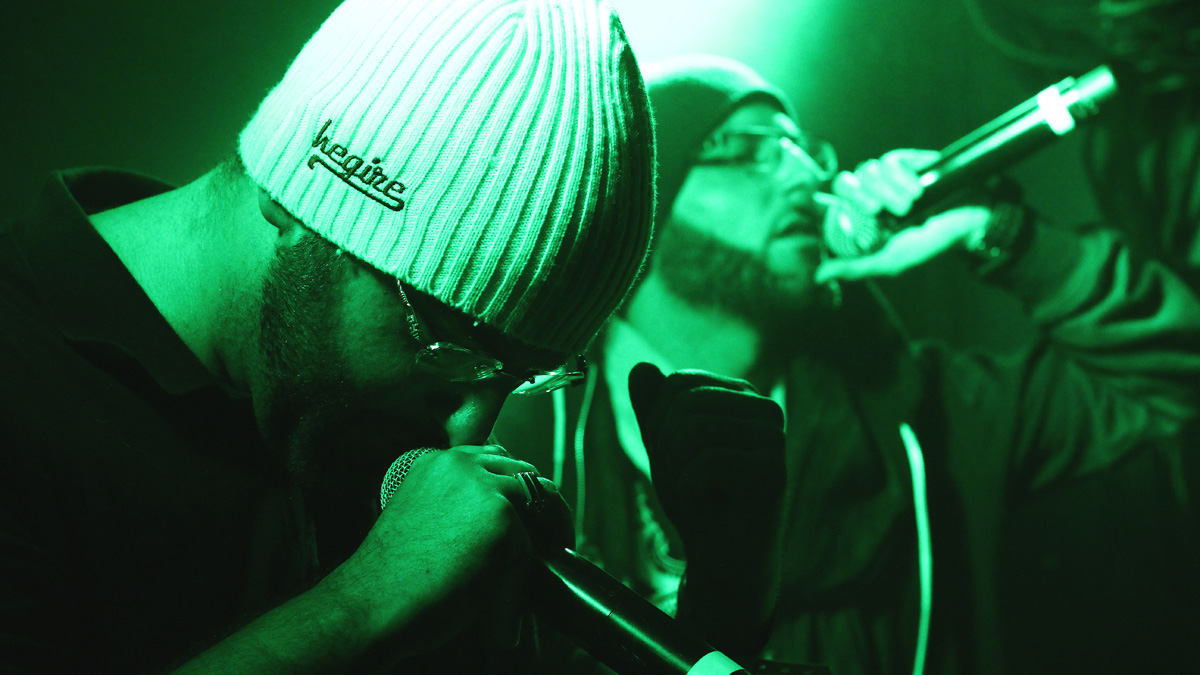 Epitome via Creative Commons; flickr.com user Coupdoreille.fr
Epitome via Creative Commons; flickr.com user Coupdoreille.fr
Today, MCs like Jay-Z, MC Lyte, and Kendrick Lamar fly loftier profiles in the globe of Hip Hop. Simply that wasn't ever the case for the poets of the microphone.
In Hip Hop's early years, its music scene focused on the disc jockey and the trip the light fantastic floor. The MC—brusque for "master of ceremonies"—was often a kind of sidekick to the DJ. InYes Yes Y'all, an oral history of early Hip Hop, Grandmaster Caz describes the ascent of MCing this way: "The microphone was just used for making announcements, like when the next party was gonna be, or people's mom's would come to the party looking for them, and you take to announce it on the mic."
Before long, though, MCs wanted to showcase their own talents. Grandmaster Caz continues: "Dissimilar DJs started embellishing what they were saying. I would make an announcement this manner, and somebody would hear that and they add together a little chip to information technology. I'd hear it again and take information technology a piffling step further 'til it turned from lines to sentences to paragraphs to verses to rhymes."
More and more, MCs earned the right to take hold of the mic using freestyle skills to entertain and command a live audience. A "master of ceremonies" might make all the needed announcements; simply the job of an MC so and now is to guide everyone's skillful time with their energy, wit, and ability to interact with people on the floor. And practiced MCs don't only demand the mic—the audience honors their skills by enervating they take information technology.
Rappers emerged as a somewhat distinct group as rap gained commercial success. They were the voices and characters that created and sold the records. In some means, the talents and responsibilities of rappers overlap with MCs, and an MC might likewise rap. The interaction with the audition is the big difference.
In 1979, a trio of MCs rapped over the suspension from Chic's "Good Times." The upshot was The Sugarhill Gang's "Rapper's Delight," rap's first striking. Three years later, Grandmaster Wink & the Furious Five releasedThe Message, a funky but unblinking account of hard times in an inner-city neighborhood. As the 1980s unrolled, MCs and rappers rose speedily from second fiddles to big dogs including Rakim, Big Daddy Kane, Run DMC, and Public Enemy. They created personas, cooler-than-life characters that might be super-smooth or gangland tough. They boasted virtually their style and talents and made sure to honor the DJ. MCing and rapping went from sideshow to principal event equally one of Hip Hop's essential elements.
Hip Hop's Rapping Poets
An MC or rapper's "catamenia" is crucial to his or her performance. The menses is the combination of rhyme and rhythm to create the rap'south desired event: fluid and soothing to communicate romance, for example; staccato and harsh to bespeak acrimony and conflict.
Before Hip Hop and rap took hold in the United states of america, spoken-discussion poesy occasionally worked its way into jazz performances. Many history-minded rappers too connect their art to The Final Poets, a Harlem-based group, and The Watts Prophets out of Los Angeles. Both emerged in the tardily-1960s and paired political poesy with improvisational jazz. Gil Scott-Heron's "The Revolution Will Not Be Televised" resembles rap before it got the proper noun.
Increasingly, students of Hip Hop culture recognize the all-time MCs as accomplished formal poets. They rap complex rhyme schemes, about built on a rock-solid four-crush rhythm, or meter. But once again, a good MC surprises audiences with syncopation and other off-the-beat techniques. Hip Hop aficionados reserve special respect for MCs with freestyle skills—the ability to improvise fresh rhymes while continuing in the heat of the spotlight.
The Sugarhill Gang - Rapper'south Delight
Hip Hop Vocabulary
MC-Terms to Know
The basic vocabulary ofMCing—Hip Hop's song style:
end rhyme rhyming words at the stop of lines
flow a rapper'south vocal mode
freestyle improvised rapping
griot (gree-OH) oral storytellers and historians of West Africa
internal rhyme rhyming words inside the same line
MC short for "master of ceremonies"; also performer who uses rap techniques to interact with an audience
meter rhythm of a poem
persona grapheme assumed past a performer
rap spoken-word lyrics performed to a beat; one of the elements of Hip Hop
rapper performer that rhymes lyrics to a rhythm
spitting speaking, performing a rap
syncopation shifting a rhythm abroad from the normal beat
Writing: Graffiti and Hip Hop Civilization
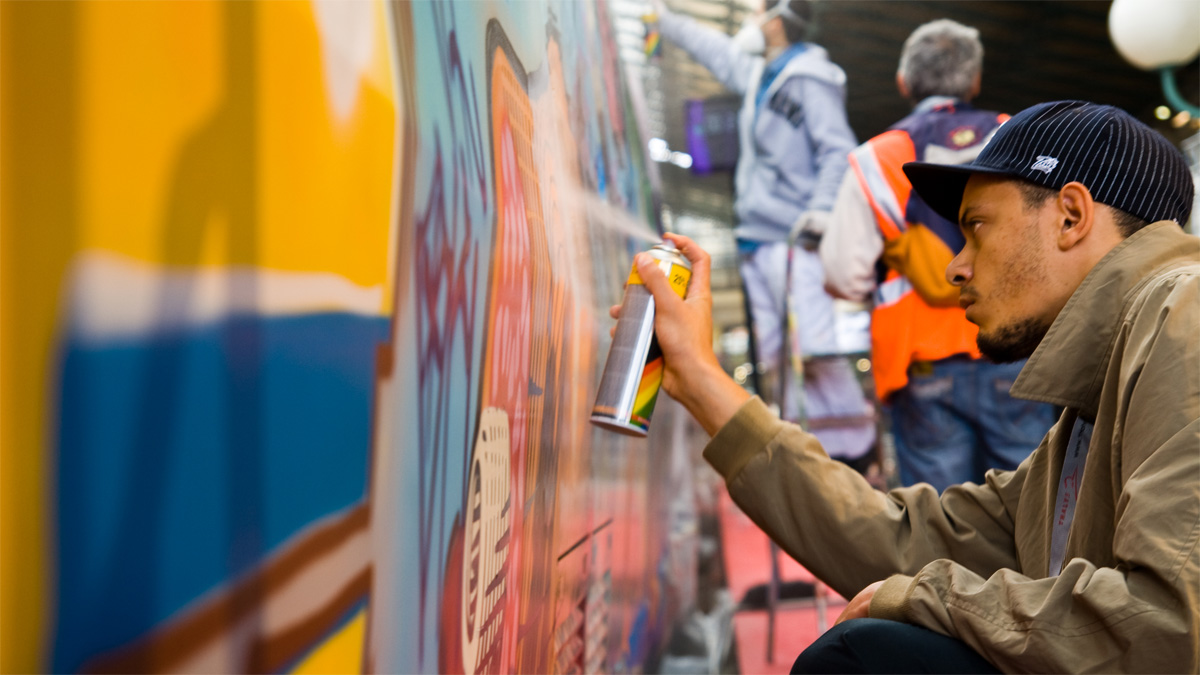 Image via Creative Commons; flickr.com user urbanartcore.european union
Image via Creative Commons; flickr.com user urbanartcore.european union
One element of Hip Hop predates the music and trip the light fantastic toe scene itself—graffiti writing, or simplywriting as the artists themselves call it. Merely information technology blossomed at the same time the music and trip the light fantastic scenes were finding their anxiety, and its wild and color-exterior-the-lines improvisational manner were influenced and inspired by the want to create something new and fresh.
Graffiti has been around since humans first painted, etched, or carved on rock walls. But urban youth put a new spin on it in the 1960s. In 1967, a Philadelphia teen named Darryl McCray spray painted his alias "Cornbread" wherever he could accomplish on walls and trains. (He was striving to print a girl named Cynthia.) In 1968, the budding fine art form made the jump to New York Metropolis. The names JULIO 204, TRACY 168, and TAKI 183 became familiar sights here, there, and increasingly everywhere.
Writing's Heyday
The number and talents of writers spiked in the mid-1970s as Hip Hop'due south competitive bulldoze kicked in. They added illustrations and 2nd colors to outline stylized chimera and block lettering. The writers—many if not most of them young teens—jumped the limits of size, complication, and color. Their finest designs seemed to bring life to any they graced. They chosen itwild style—and it was.
They also jumped over fences, sneaked into subway tunnels, and trespassed in night yards where subway cars slept. There, they proficient their art with blank walls and unstained trains as their canvases. When opportunities arose, they painted the whole sides of subway cars and fifty-fifty entire ten-auto trains with their elaborate, colorful designs.
They had no illusions their creations would last long. Merely the opportunity to come across their art rolling through the subway was the ultimate payoff for writers like DONDI, LADY PINK, FAB FIVE FREDDY, KASE2, and ZEPHYR. Information technology was outrageous to think thousands of New Yorkers saw their creations each day in one of the richest cities in the world. "If art like this is a crime let god forgive me!" wrote the writer known equally LEE of the Fabulous V crew. They embraced the identity of outlaw artists and admitted the dangers and thrills were part of the entreatment. They were on missions to show they were not but the almost imaginative and talented writers in their neighborhood, but the nearly fearless.
Not surprisingly, NYC officials were not amused. Cops cracked down on writers, and railroad train yards were encircled with new security. At the same fourth dimension, the art world was catching on that something fresh was happening in the city across their fancy uptown galleries. Graffiti-inspired exhibitions popped up, and some writers took the opportunity to commit their passion to canvas instead of granite and steel.
Wild, Hungry, Inspired
Writing's place in Hip Hop civilization was cemented past the early 1980s. Early on rappers used wild way on their album covers. Writers painted cool kids' clothes with designs and got paying gigs painting murals. And two movies—Manner Wars andWild Fashion—debuted. The films made the example that a similar hungry, inspired creativity flowed through writing as well as Hip Hop's music and dance scene.
Today, graffiti-influenced writing styles show upwardly worldwide in graphic blueprint, fashion, and street art. Outlaw artists like Banksy are nonetheless out there painting problem. But the vision, passion, and humour the all-time of these writers brandish—legit or not—give people the chance to run across the work-a-day world in new ways. They seem to say if we pay attending, we can notice dazzler, meaning, and art most everywhere nosotros expect.
Dan 1: Alphabetical Engineer
Hip Hop Vocabulary
Writing Terms to Know
The basic vocabulary ofwriting graffiti—Hip Hop's visual art include:
all city being known for one'south graffiti throughout a city; originally referred to the artwork on subway cars appearing in all five New York City boroughs
bite to steal another writer'southward pattern or style
black book sketchbook used by graffiti writers
bombing to paint many surfaces in an area
burner elaborate, big designs
crew squad of writers that often work together
gettin' upward developing one's reputation or "rep" through writing graffiti
graffiti writing, or drawing on surfaces in public places, usually without permission
kings orqueens highly respected, experienced writers with nearly tags
slice brusque for "masterpiece," a large, complex graffiti design
stencil graffiti premade designs of paper or cardboard that permit quicker, more exact transmission of images or lettering
tag orscribble stylized, just basic graffiti writer's signature
throw upward quick execution writing; generally one colour outline and i color filled in
toy inexperienced writer
wild style style of writing that normally involves assuming, interlocked letters
writergraffiti artist who has a distinct fashion they blueprint their messages
Knowledge: A Philosophy of Hip Hop
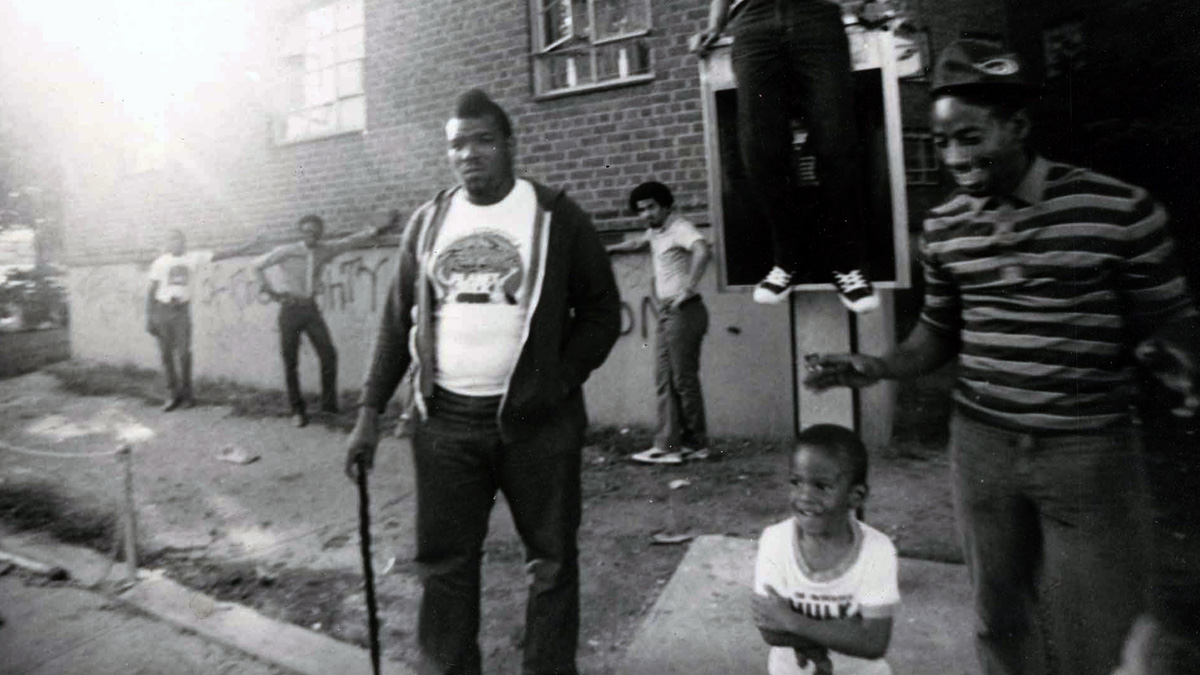 Afrika Bambaataa at Bronx River Projects, photo by Sylvia Plachy
Afrika Bambaataa at Bronx River Projects, photo by Sylvia Plachy
The 1970s were lean, hateful years in sections of New York Urban center. This was especially true in the Bronx and the metropolis'south other low-income areas. Much of the optimism of the 1960s Civil Rights Motion had faded. New York was broke. City officials sliced and diced basic services, school funding, arts education programs, and job training. Life-destroying drugs and crime haunted the streets. Absentee landlords neglected properties until building after building fell into disrepair or went upwardly in flames.
In the face of all that, withal, the energy of urban youth refused to close down. Immature people, many of them teens, created new ways of spinning records and dancing. They experimented with new styles of poetry and visual art that revealed their thinking and feelings. Eventually, the elements grooved together into a culture. A name started to stick to it:Hip Hop.
The Fifth Element
Hip Hop'due south fifth chemical element of "knowledge" teaches the Hip Hop community nigh its identity and ways to limited that identity. It places corking importance on claiming a stake in one's ain education. "Knowing where Yous come from helps to testify You lot where YOU are going," writes legendary MC KRS-I. "Once you know where y'all come up from you then know what to learn." (By the fashion, "KRS" stands for "Knowledge Reigns Supreme.")
Hip Hop believes that people can have control of their lives through self-cognition and self-expression. Knowledge influences way and technique and connects its artists nether a collective Hip Hop umbrella. It engages the world through Hip Hop'southward history, values, and ideas, and adds intellectual musculus to back up and inform its music and moves and its poetry and art. Well-nigh chiefly, it allows for a shared experience confronting an uncertain globe.
Bambaataa Brings It
Afrika Bambaataa deserves much credit for putting this concept of knowledge into discussion and action. Bambaataa is a pioneering DJ and MC from the Bronx. A old teen leader of a gang, Bambaataa had universal respect and a powerful ability to make peace with and between enemies. His legendary music and dance parties brought together rivals to party in peace. "Gratuitous jam!" his flyers announced. "Come one come up all, get out your colors at home! Come in peace and unity."
The young Bambaataa was as well a devoted pupil of history. He absorbed the tactics and strategies of historical leaders—from the French emperor Napoleon to the S African chieftain and war machine commander Shaka Zulu. He grasped the power of music as a strategy for immigration barriers that divided people, whatever their backgrounds.
Past the 1980s, Bambaataa and his big and growing crew had founded the Universal Zulu Nation. Dedicated to Hip Hop values, the organisation's motto is "Peace, Love, Unity, and Having Fun." They developed "Infinity Lessons"—principles and codes of conduct for living an honorable Hip Hop life. They emphasize customs, peace, wisdom, freedom, justice, love, unity, responsibility, respect for others, and respect for self. He put his cognition into words, and the words radiated effectually the Bronx, throughout New York, and beyond America.
Boogie Downward Productions - My Philosophy
Hip Hop Vocabulary
Noesis Terms to Know
The basic vocabulary ofknowledge—Hip Hop's philosophy include:
civilisation the behaviors and beliefs of a particular group of people
didactic intended to teach a lesson, especially a moral lesson
empowerment increasing of economic, political, social, educational, gender, or spiritual strength of individuals or communities
praxis procedure when a theory, custom, or lesson is adept
society social, economic, and cultural system
strategy plan to reach a desired result
worldview ideas about how the earth works
Hip Hop Theater and Literary Arts
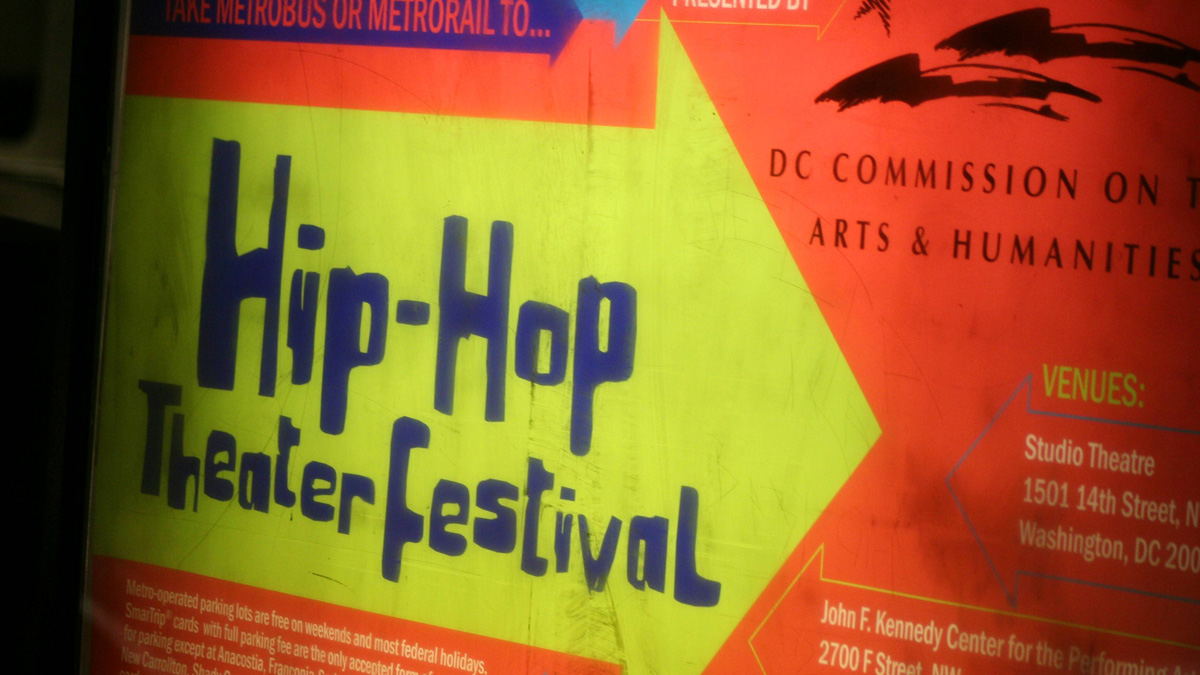 Image via Creative Eatables; flickr.com user Elvert Barnes
Image via Creative Eatables; flickr.com user Elvert Barnes
"Be warned, thisis theater—simply it'southHip Hop theater," a loud voice booms before the curtain rises forInto the Hoods. This show has been blowing abroad London audiences since 2008. Information technology is an urban re-visioning of the fairy tale-genre, following a pair of schoolhouse kids into a tough office of town instead of a haunted forest. But equally with all fairy tales, non everything or anybody is what they seem. Ultimately the stage blazes with wild style art, DJ voiceovers, beats from multiple musical styles, b-boys and b-girls breaking in high-flying choreography, and fresh takes on familiar characters. (DJ Spinderella or Rap-On-Zel band a bell?)
More and more, the stage has been welcoming Hip Hop's elements, energy, and world view. Graffiti writing may splash across the scenery. DJing, rapping, and breaking are likely to take turns in the spotlight. Some shows, likeInto the Hoods, tell their tales mainly through trip the light fantastic toe and music, while others lay Hip Hop style over more than traditional scripts. Hip Hop artists are tackling drama, comedy, and tragedy, and some classic fabric is getting the Hip Hop makeover. Will Ability'sThe Seven, for case, retells the ancient Greek tragedyVii Against Thebes past Aeschylus using a DJ and rapping cast.
Collaboration and Content
Collaboration is a cadre ingredient for most Hip Hop theater groups. In the tradition of the civilization, producers, directors, and playwrights stress input and participation by stakeholders—the very people the play is intended to speak to and entertain. Long-time Hip Hop theater writer/actor/director Danny Hoch says it this mode: "Hip-hop theatre… must bepast,well-nighandfor the hip-hop generation, participants in hip-hop civilization, or both."
This collaborative process clearly informs the content in Hip Hop plays and musicals. Plots often tackle current social issues, especially as they relate to urban communities, with characters exploring the strengths and limits of activism and empowerment. Questions of identity are often front and middle, including race, class, gender, sexuality, and annihilation regarded as "different." The struggle betwixt the individual and society is a key theme as characters seek to create meaning in their lives while struggling to claim their place in the world.
Hip Hop in Prose and Poesy
MCs tell complex stories in rhythm and rhyme. Rappers write and shine their lyrics before delivering them in raps. The surreptitious is out: Hip Hop poets honey words. "The toughest, coolest, about unsafe-seeming MCs are, at middle, basically simply enormous linguistic communication dorks," cracks music critic Sam Anderson. "They dearest puns and rhymes and slang and extended metaphors …." These skills can interpret smoothly into literary forms—curt stories, novels, scripts, verse, and comic book-style graphic novels. Some works relate the gritty realities of poverty or inner-city living; others observe the humour there and wherever; all describe trying to survive and thrive in a quickly irresolute globe.
Rapped aloud or published on paper, Hip Hop-influenced literary forms accept roots in the Blackness Arts Motion of the 1960s. BAM inspired a generation of African American, Latino, and feminist writers, including Amiri Baraka, Maya Angelou, Nikki Giovanni, Sonia Sanchez, the Last Poets, and many others, to share stories and views often overlooked or outright rejected by mainstream America. Forth the way, spoken discussion—a forerunner of rap—injected energy into operation. Through poetry slams, information technology has developed its own fans with its forceful, fun wordplay.
As in theater, the literary earth is making more space for Hip Hop style, subjects, and themes. Scholars Andrew DuBois and Adam Bradley recently edited and publishedThe Anthology of Rap, a huge drove of lyrics. Says Bradley: "[R]appers are perchance our greatest public poets, extending a tradition of lyricism that spans continents and stretches back thousands of years… They expand our agreement of human experience by telling stories we might non otherwise hear."
Some Hip Hop-savvy teachers are bringing the best of Hip Hop literature into their classrooms. And writers for kids, teens, and young adults are telling Hip Hop tales in books likeThink Again by Doug E. Fresh, Debbie Allen'sBrothers of the Knight, and theHip-Hop Kidz series by Jasmine Bellar.
Hip Hop Vocabulary
Theater and Literary Terms to Know
The bones vocabulary ofHip Hop theater and literary arts include:
choreography arrangement of dance moves
collaboration working together
content discipline or information
genre category of literature, such as fairy tales or historic fiction
lyricism poetic or musical style
metaphor symbolic figure of speech
scenery backdrop for a theater production
stakeholder someone who shares involvement or responsibility
All The Way Alive - Hip Hop Connections

-
Writer
Sean McCollum
-
Editor
Lisa Resnick
-
Producer
Kenny Neal
-
Updated
October thirty, 2019
Related Resources
Hip Hop Culture
Hip Hop embraces these artistic elements, most definitely. Merely it too has composite and transcended them to become a means for seeing, jubilant, experiencing, understanding, confronting, and commenting on life and the world. Hip Hop, in other words, is a way of living—a culture.
Hip Hop to da Head
This performance explores the Hip Hop dance and music move including crush boxing, breaking, locking, floor piece of work and top rock.
DJ 101
In this video series, turntablist Kuttin Kandi, one of the best boxing DJs in the game, demonstrates the nuts of her instrument.
slamKC
Explore the performances of immature slam poets. Musical, lyrical, and provocative, these original spoken word pieces are supported by Hip Hop giants Questlove and Blackness Idea.
Kennedy Centre Education Digital Learning
Eric Friedman
Director, Digital Learning
Kenny Neal
Managing director, Digital Education Resource
Tiffany A. Bryant
Assistant Manager, Audience Enrichment
Joanna McKee
Plan Coordinator, Digital Learning
JoDee Pair of scissors
Content Specialist, Digital Learning
Connect with u.s.a.!
![]()
![]()
![]()
![]()
![]()
![]()
Generous back up for educational programs at the Kennedy Center is provided by the U.S. Section of Pedagogy.
Gifts and grants to educational programs at the Kennedy Center are provided by A. James & Alice B. Clark Foundation; Annenberg Foundation; the Andrew Due west. Mellon Foundation; Depository financial institution of America; Bender Foundation, Inc.; Carter and Melissa Cafritz Trust; Carnegie Corporation of New York; DC Committee on the Arts and Humanities; Estée Lauder; Exelon; Flocabulary; Harman Family unit Foundation; The Hearst Foundations; the Herb Alpert Foundation; the Howard and Geraldine Polinger Family Foundation; William R. Kenan, Jr. Charitable Trust; the Kimsey Endowment; The Male monarch-White Family Foundation and Dr. J. Douglas White; Laird Norton Family Foundation; Little Kids Rock; Lois and Richard England Family unit Foundation; Dr. Gary Mather and Ms. Christina Co Mather; Dr. Gerald and Paula McNichols Foundation; The Morningstar Foundation; The Morris and Gwendolyn Cafritz Foundation;
Music Theatre International; Myra and Leura Younker Endowment Fund; the National Endowment for the Arts; Newman'south Own Foundation; Nordstrom; Park Foundation, Inc.; Paul M. Angell Family Foundation; The Irene Pollin Audience Evolution and Community Date Initiatives; Prince Charitable Trusts; Soundtrap; The Harold and Mimi Steinberg Charitable Trust; Rosemary Kennedy Education Fund; The Embassy of the United Arab Emirates; UnitedHealth Group; The Victory Foundation; The Volgenau Foundation; Volkswagen Group of America; Dennis & Phyllis Washington; and Wells Fargo. Additional support is provided by the National Committee for the Performing Arts.
The content of these programs may have been developed under a grant from the U.Due south. Department of Education but does non necessarily represent the policy of the U.S. Department of Education. Yous should not assume endorsement past the federal government.
Source: https://www.kennedy-center.org/education/resources-for-educators/classroom-resources/media-and-interactives/media/hip-hop/hip-hop-a-culture-of-vision-and-voice/
0 Response to "Did Baby Bash Go to Classic Fun Center"
Post a Comment